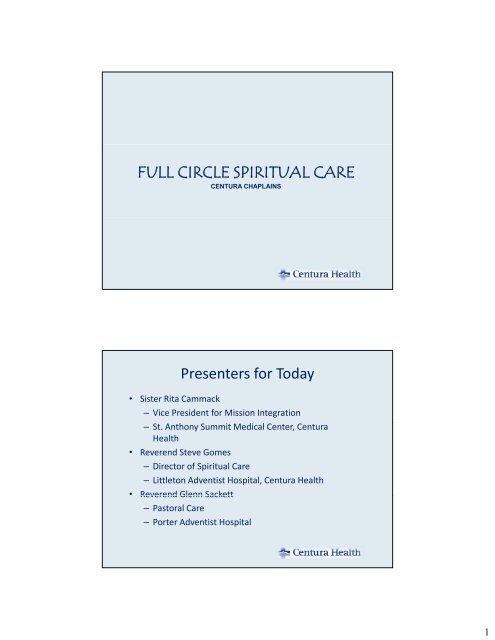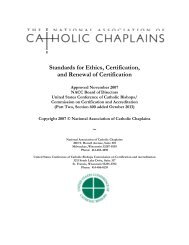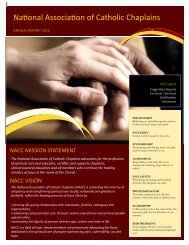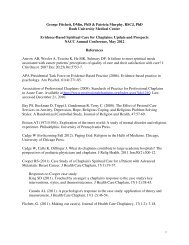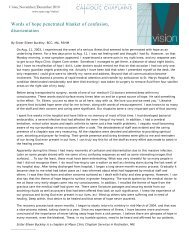FULL CIRCLE SPIRITUAL CARE Presenters for Today
FULL CIRCLE SPIRITUAL CARE Presenters for Today
FULL CIRCLE SPIRITUAL CARE Presenters for Today
- No tags were found...
You also want an ePaper? Increase the reach of your titles
YUMPU automatically turns print PDFs into web optimized ePapers that Google loves.
<strong>FULL</strong> <strong>CIRCLE</strong> <strong>SPIRITUAL</strong> <strong>CARE</strong>CENTURA CHAPLAINS<strong>Presenters</strong> <strong>for</strong> <strong>Today</strong>• Sister Rita Cammack– Vice President <strong>for</strong> Mission Integration– St. Anthony Summit Medical Center, CenturaHealth• Reverend Steve Gomes– Director of Spiritual Care– Littleton Adventist Hospital, Centura Health• Reverend Glenn SackettReverend Glenn Sackett– Pastoral Care– Porter Adventist Hospital1
Our Goal <strong>for</strong> <strong>Today</strong>As a result of the workshop, you will:• Be able to identify the major components of Full CircleSpiritual it lCare.• Understand how the medical model of “assess, plan,intervene, evaluate” translates into Pastoral practice inthe hospital setting (i.e. taking apart our “ministry”).• Understand what it means to be outcome oriented.• Identify how caring <strong>for</strong> the soul might be documentedin an electronic charting system.Through the Ages• Anton Boisen, Richard Cabot, Russell Dicks• The Pastoral Care Movement –ACPE, APC, CAPPE,NACC, NAJC, etc.• Paul Pruyser• Elisabeth McSherry, M.D., Greg Stoddard, GeorgeFitchett, Larry VandeCreek, et.al.• Art Lucas –“The Discipline <strong>for</strong> Pastoral Care Giving”• Gordon Hilsman• Full Circle Spiritual Care2
When we provide“Full‐Circle Spiritual Care”we’re offering to walk with another person,from needs‐based problemsto resource‐based outcomes,all within a spiritual & theological context.“Full‐Circle Spiritual Care”is an outcome‐oriented spiritual care model.Full‐Circle Spiritual Care is fivefoldOutcome /EvaluationRapportBuildingInterventionAssessmentSpiritualCare Plan3
Full‐Circle Spiritual CareOverviewWhat’s Next?Spiritual i lOutcomesSpiritual InterventionChart persons assessment and outcome.Identifying the results of your full‐circle spiritual care and whatthe two of you have accomplished.Assisting the person in choosing, from their perspective, anappropriate “next step” supporting their needs/desires/resources.utcomesOuInterventionBeing PresentShowing UpFeelings &EmotionsStory ListeningiEngagingEmpathySpiritual Care PlanSpiritual AssessmentWith the person’s “consent,” develop a plan of care. (Spiritual & religious support;Ethics, advocacy & referral support; Change, adjustment & loss support; Emotional support, and Leadership & advocacy)Assessing the person’s needs, desires & resources within the context ofMeaning, Hope, Relationship/community and Holy.Bringing empathy and understanding to the situation. Withholding judgment. Being self‐aware and reactingappropriately. Bringing a compassionate objectivity <strong>for</strong> both the individual/family and the care givers.Identifying the persons emotions and feelings. Using your understanding of the situation, story and empathy toenable the person to begin identifying, naming and accepting their feelings and emotions.Focus, follow, and ask open questions around the person’ss story. Explore the content and emotions presented.Revealing, sharing and expressing empathy.Finding a relational way to connect with the patient, family member or associate. Two‐way engagement with anawareness of what I bring to the relationship. Engaged/active listening.Attend to the person’s needs, rather than only our own thoughts, feelings, or our need to help/minister/fix.Determine need and timing of visit. What is the person’s need? Self‐Awareness of what I bring to the situation.PlanAssessmentRapport BuildingSpecial thanks to Steve Gomes <strong>for</strong> the stair step concept and initial categories.Our Full‐Circle (Spinning)* Care• We constantly move through the five phases of “Full CircleSpiritual Care”. They are– Rapport Building– Spiritual it lAssessment– Spiritual Care Plan– Spiritual Interventions, and– Identifying Outcomes• Skills– Engaged communication– Understanding and acceptance of process– Intuition– Curiosity, Critical thinking & Creativity– Presence, self‐awareness, mindfulness• * Remember the analogy of the beach ball, blown up to spin and play with, deflated and flattened to examinethe intricacies of the design. It is like this with Full Circle Spiritual Care. We do ‘spiritual care’ without takingapart the steps. However, in order to understand, discuss and learn more about the spiritual care we provide,we must flatten the process <strong>for</strong> examination.4
RAPPORT BUILDINGFull‐Circle Spiritual CareRapport BuildingBeing PresentShowing UpEmpathyFeelings &EmotionsBringing empathy and understanding to the situation. Withholding judgment. Being self‐aware and reactingappropriately. Bringing a compassionate objectivity <strong>for</strong> both the individual/family and the care givers.Identifying the persons emotions and feelings. Using your understanding of the situation, story and empathy toenable the person to begin identifying, naming and accepting their feelings and emotions.Focus, follow, and ask open questions around the person’s story. Explore the content and emotions presented.Story ListeningRevealing, sharing and expressing empathy.Finding a relational way to connect with the patient, family member or associate. Two‐way engagement with anEngagingawareness of what I bring to the relationship. Engaged/active listening.Attend to the person’ss needs, rather than only our own thoughts, feelings, or our need to help/minister/fix.Determine need and timing of visit. What is the person’s need? Self‐Awareness of what I bring to the situation.pport BuildingRa5
Rapport BuildingShowing UpOutcome /EvaluationRapportBuildingBeing PresentEngagingInterventionAssessmentStory ListeningSpiritualCare PlanFeeling & EmotionEmpathy“We’re offering to walk with the other person.”Showing up• Receive Referral ‐ as appropriate, check chart and talkwith care team• Assess Patient Need ‐ “Spiritual Acuity”– Spiritual Strengths– Spiritual Concerns– Spiritual Distress– Spiritual Despair– Spiritual Crisis ‐ Code Blue, etc.• Which need is priority?• Assess the timing ‐ When to show up• Assess other care giver needs (nurses, techs, etc.)• Self awareness ‐ What agenda, emotions you bring tosituation6
Being Present• Attend to the person’s needs, rather than only my thoughts,feelings or my need to minister/help/fix.• Ati Active vs. Passive presence?• Present <strong>for</strong> whom ‐ patient, family, staff, etc.?• Who is available to engage?• What are the relational dynamics?• Self‐assessment ‐ what is competing <strong>for</strong> my attention?• What else is going on?Engaging• Finding a relational way to connect with thepatient/family or the associate.– Who am I engaging with?– What is the most effective way to engage?• Two‐way engagement –self and otherawareness.7
Story listening• Around the person’s “presented material,”– Focus– Follow– Open questions unwrapping the person’s story• Exploring content• Discovering emotions presentedIdentifying Emotions & Feelings• Identifying and naming the person’s emotions andfeelings• Self‐awareness , the specific feelings generated tdwithinyourself• Using this self‐awareness to walk with the patient into theissues they are presenting• Getting to the “heart” of the matter8
Empathizing• “Feeling into” the persons situation (Heinz Kohut)– Empathy rather than judgment• Journeying into their experience, while hl beingaware of how it touches your own• Appropriate use of self• Bringing a compassionate objectivity <strong>for</strong>individual, family, loved ones and care givers<strong>SPIRITUAL</strong> ASSESSMENT(IN-DEPTH)9
Spiritual AssessmentOutcome /EvaluationRapportBuildingWithin the context of Needs,Resources, Goals/DesiresInterventionAssessmentMeaning, Hope Community & HolySpiritualCare Plan“From needs-based problems, to resource-based outcomes.”Full‐Circle Spiritual CareSpiritual AssessmentFeelings &EmotionsStoryListeningEmpathySpiritualAssessmentAssessing the person’s needs, resources & desires within thecontext of meaning, hope, relationship/community & holy.Bringing empathy and understanding. Withholding judgment. Beingself‐aware and reacting appropriately. Two‐way engagement with awareness.Identifying the person’s emotions/feelings. Using your understanding to enablethe person to begin identifying, naming and accepting their feelings and emotions.Focus, follow, and ask open questions around the person’s story. Explore the contentand emotions presented. Revealing, sharing and expressing empathy.Assessment10
Needs, Desires & ResourcesThe complexity that people bring to the hospital is greaterthan these concepts –Feelings Community Relationships RoleVocation World View Life Script WillAbility to Religious Dreams Shoulds OughtTrust History Practices PresentFamily I‐‐Thou Transcendent BeautyPurpose Story Ultimate ValuesFaith Journey Identity CultureSpiritual Assessment• Specifically identifying the person’s– Needs/resources– Desires/goals• Within the context of 1 ;– Meaning,– Hope,– Relationship/Community, and– Holy (be willing to explore the two aspects of ‘divinity’ &‘humanity’).• Important components of the assessment will include– The term assessment derives from Latin “ad”, next to, and “sedire”, tosit. There<strong>for</strong>e, “first to quietly sit close.”– Spiritual assessment is a partnering endeavor between the person(s)receiving care and the spiritual care giver.1Acknowledgement: Our framework <strong>for</strong> spiritual care utilizes Arthur Lucas's categories (Meaning,Hope, Community and Holy) and several concepts identified by Larry VandeCreek in The Discipline <strong>for</strong>Pastoral Care Giving.11
Sense of Meaning• Sense of identity and self awareness• Sense of purpose and direction• Ability to contribute• Find meaning in present situation• Role and purpose within surroundings• Sense of value and participation withinexisting relationshipsFrom the Patient’s PerspectiveMeaning – Desires & Resources• I have places to go, people to see, things to do and plans toaccomplish. I can make a difference, whether in work, play orinteraction with others.• I don’t like what is happening, but I can think through thesituation.• With my limitations and gifts, even if it is less, I have somethingof value to offer.• What can I learn and how can I be trans<strong>for</strong>med dby myexperience?• My life will end, but I’m full of curiosity, adventure,wonderment and willingness to explore possibilities. I remainengaged with God, family and community.12
From the Patient’s PerspectiveMeaning – Need• No interest in tomorrow.• Who cares? Meaningless, nothing I do matters.• I don’t understand. All the old answers don’t work.• What difference does it make? I’m worthless.• This is meaningless suffering, nothing but random acts ofbadness or unfairness.• I’ll just give up, I’ll deny reality and filt fail to live honestlywith others.• Future worth havingSense of Hope• Resilience over despair• Hopeful• Will to continue• Sense of future possibilities• One day at a time & endurance in themoment13
From the Patient’s PerspectiveHope – Desires & Resources• I discuss and plan <strong>for</strong> the positive things I’ll do when I getout of here.• I’m committed to getting better, no matter what it takes.• I’m willing to invest in the future. I expect good tohappen.• I can make what I need happen.• There are so many possibilities yet to achieve.• I’ll take the challenges a piece at a time and life will be OK.From the Patient’s PerspectiveHope – Need• I don’t have any reason to get better.• Nothing is going to make any difference, limitedpossibilities.• There is no reason to invest energy in the future.• I’ve given up.• Futility of the past and futility of the future.• Immobilized and overwhelmed hl dby obstacles. bt 14
• ConnectednessSense of Community• Sense of belonging• Relationships contribute to my well being• Sense of <strong>for</strong>giveness• Integration of grace and reconciliation• Sense of gratitude and thankfulnessFrom the Patient’s PerspectiveCommunity – Desires & Resources• My relationships are positive, they support & strengthen me.• My relationships are important; I’m engaged in give‐andtake.• Relationships are present, constructive, supportive and bringout the best in me and others. I’m loved and cared <strong>for</strong> in away that helps me grow.• Life is too short not to <strong>for</strong>give. I readily give and receive<strong>for</strong>giveness.• I live in the experience of grace and restored relationships.• I live in appreciation <strong>for</strong> what others do and how they care.15
From the Patient’s PerspectiveCommunity – Need• Distant, destructive relationships, excommunicated orignored• No one will miss me when I’m gone.• Relationships are absent, destructive and bring more painand suffering which enables my self‐destructive behavior.• Revenge is the answer <strong>for</strong> me! I can’t give or receive<strong>for</strong>giveness.• No hope <strong>for</strong> relationships and I hold onto betrayals fromthe past or present.• Life is judgmental and full of disruptive, brokenrelationships.Sense of Holy• Relationship with something/someonegreater, beyond or within.• Sense of Holy as a resource.• Sense of connectedness with Holy.• Com<strong>for</strong>t with human limitations.• Sense of being <strong>for</strong>given, ,grace &reconciliation.• Sense of gratitude.16
From the Patient’s PerspectiveHoly – Desires & Resources• I have a sense of awe, wonder and appreciation <strong>for</strong> being apart of a Divine plan that I bring into my awareness, myconversations and relationships.• My understanding of the Holy is a resource <strong>for</strong> thebetterment of myself and my community. My Holy providesme with good things and positive experiences.• God is there <strong>for</strong> me, available to help, surrounding me withhis/her presence.• Serenity prayer. Reasonable expectations, “Let go, let God.”• I’m blessed with “What I have,” and am full of appreciationand gratitude.From the Patient’s PerspectiveHoly – Need• Unresolved guilt and shame.• I identify the Holy as negative, unpleasant or destructiveand I have a direct sense of alienation which is manifestedas absence or conflict with the Holy.• Prayers aren’t answered; God’s gone & isn't interested inme.• I just can’t do enough; I’m Im so imperfect and judgmental ofmyself. I’ve probably committed the unpardonable sin.• Nothing but a fear of judgment and condemnation.• Which in turn renders me judgmental, critical and unableto be appreciative or thankful.17
Spiritual AssessmentResources, Desires & NeedsMeaning Hope Community Holy<strong>SPIRITUAL</strong> <strong>CARE</strong> PLAN18
Full‐Circle Spiritual CareOutcome /EvaluationRapportBuildingInterventionAssessmentSpiritualCare PlanFull‐Circle Spiritual CareSpiritual Care PlanSpiritual Care PlanWith the person’s “consent,” develop a plan of care. (Spiritual & religioussupport; Ethics, advocacy & communication support; Change, adjustment & loss support;Emotional support, and Leadership & advocacy support)• An action or set of actions;Identified by the spiritual care provider,Agreed upon by the patient, family and loved ones,Implemented in response to spiritual needs, desiresand resources, andIdentified in the spiritual care assessment.• The creation of this plan is an intermediate stage of thespiritual care process.• This plan guides the ongoing provision of care and assistsin the evaluation of this spiritual care.19
Characteristics of a Spiritual Care Plan• Designed with the awareness, collaboration andconsent of the patient, family and loved ones• Focused on actions which are identified to respondto the patients existing resources, needs and desires• Emerges from a deliberate, systematic spiritual careassessment• Relates to the future• Is holistic• Stated in the positive and communicated as patientand family focused• Outcome focusedAspects of Creating a Spiritual Care Plan• Awareness• Collaboration• Consent• Communication20
Awareness• What interests and issues play into thedevelopment of a spiritual care plan (SCP)?– My level of rapport, preconceptions, biases andlevel of personal awareness– What theological/philosophical and behavioralbasis am I operating from– Care Team perspective(s)– The Physician(s) )perspectivep– My role within the Care Team• What we’ve learned from the spiritualassessmentCollaboration• Who is involved and who needs to be involved?– Patient– Family/loved ones• All or some?• Who is the spokesperson?• How are decisions made?– Care team• Role of the chaplain in being aware of the team’sissues?• Of aligning the team?– Physician– Faith community21
Consent• Implied & Implicit– Willingness to enter into aconversation, to “dance”, tocontinue talking– Following up on a referral, walkingin the room• Implied & Explicit– “I want to create an end of liferitual <strong>for</strong> your family, is that OK?”• In<strong>for</strong>med & Explicit– Anointing of the sick– Donor Requestor• In<strong>for</strong>med d& Implicitit– Ethics consult– Life review• Formal– Electronic records– Notification• In<strong>for</strong>mal– Conversations with• Patient and family• Care team• PhysicianCommunication22
Spiritual Care Plan• A set of goals and planned interventions basedupon the patient’s assessed needs, resourcesand desires– Patient and family/loved ones focused– Action‐oriented & stated in the positive– In<strong>for</strong>med by rapport building, the spiritualassessment and within the context of awareness,collaboration, consent and communicationThe Spiritual Care Plan has been the most invisible aspect of this spiritualcare model, however we believe it may be the most crucial aspect toin<strong>for</strong>m actions and outcomes.INTERVENTIONS(<strong>SPIRITUAL</strong> ACTION)23
Full‐Circle Spiritual CareInterventionSpiritual InterventionAssisting the person in choosing, from their perspective, anappropriate “next step” supporting their resources, needs & desires.InterventionsOutcome /EvaluationRapportBuildingSpiritual &Religious egousSupportEthics,advocacy &communicationsupportSpiritualCareInterventionAssessmentPlanSpiritualCare PlanChange,adjustment &loss supportEmotionalsupportOrganizational Care24
Getting Started• in∙ter∙ven∙tion– Interference so as to modify a process orsituation.– To involve oneself in a situation so as to alter orhinder an action or development.– Any measure whose purpose is to improvehealth or alter the course of disease.– An intervention designed to improve the healthof a patient or change the conditions whichhave negative impact on the well‐being of thepatient.Spiritual & Religious Support• Patient received sacramental / ritual care• Patient able and willing to use their religious supportsystem• Chaplain helped patient clarify values and beliefs relevant<strong>for</strong> situation• Chaplain attended to confession, <strong>for</strong>giveness andreconciliation• Chaplain provided spiritual guidance• Chaplain and patient discussed patient’s spiritual journey• Patient was referred to appropriate spiritual resources25
Spiritual & Religious Support (Meditech)Provide sacrament/ritualOffered religious supportExplored values/beliefsAttended to <strong>for</strong>givenessExplored spiritual lifeSpiritual guidanceGiven spiritual resourcesEthics, advocacy, & communication support• Patient discussed and addressed relevant ethical issues• Chaplain provided appropriate care <strong>for</strong> family and lovedones• Chaplain advocated <strong>for</strong> patient• Patient received appropriate mental health and/oraddiction care• Patient was referred to the appropriate resources• Patient received Advance Directive education• Chaplain facilitated care discussion26
Ethics, advocacy, communication &support (Meditech)Discussed d ethical issues R iSupported pt’s loved onesAdvocated <strong>for</strong> pt.Mental health supportAddiction supportResources givenAdv. Directive reviewEthics consultFamily conferenceCare discussion (could beinterdisciplinary rounds)Change, Adjustment & Loss Support• Patient and chaplain discussed and identified changes inpresent life stages/journey• Chaplain provided d grief ifsupport and counseling• Patient and chaplain discussed end of life issues and care• Chaplain provided loss, change, and adjustment support• Patient & chaplain discussed change that is taking place &necessary support• Patient was referred to appropriate p resources27
Change, Adjustment & Loss Support(Meditech)Discussed life stagesProvided grief supportEnd of life discussionLoss/change supportSupport systems exploredProvided referralEmotional Support• Chaplain provided crisis support and ministry• Chaplain provided support and validation of care• Chaplain provided in<strong>for</strong>mation and answered questions• Patient and chaplain identified networking and resources28
Emotional Support (Meditech)Crisis supportEmotional supportProvided in<strong>for</strong>mationResources identifiedSupported pt’s loved onesCompanionedOrganizational Leadership,Advocacy & Support• Organizational soul care• Organizational conscience• Mentor and confidant to leadership• Mission and value education• Staff support and debriefing• VIA support & training• Leading Rituals29
Working Together• Inter‐disciplinary approach– Chaplain’s role as coordinator/facilitator of thecare team.– Chaplain’s role with patient, family and others• In the context of MeditechAttended d dto <strong>for</strong>givenessComment section:–Patient will talk with brother regarding . . .MOVING TO OUTCOMES30
OutcomesOutcome /EvaluationRapportBuildingWhat difference did this interactionmake? To whom?InterventionSpiritualCare PlanAssessmentHow will I communicate what needsto be shared? To whom?Are there any furtherrecommendations or referrals?Identify the observable change following and resulting from a spiritualintervention. This change may be connected to the patient’s spirituality, religiousbelief(s), religious practices, the effective engagement with members of the careteam or the treatment regime itself.Why Outcomes are Important• Outcomes:– Are the focus of what we do– Allow us to report the impact we’ve hd had– Enable us to provide relevant and helpfulin<strong>for</strong>mation to the care team, using their language,being a part of our overall care to the patient andtheir family/loved ones.– Care Team’s move toward Evidence BasedMeasurements– We’ll integrate where appropriate• See the next two slides• Watch <strong>for</strong> additional ideas and training31
Full‐Circle Spiritual CareOutcomesWhat’s Next?Spiritual OutcomesChart persons assessment and outcome.Identifying the outcome of your full‐circle spiritualcare and what the two of you have accomplished.OutcomesIdentifying Outcomes• Observation –Sensory Report(s)– What is observed by chaplain or interdisciplinary team• Changes in: facial expression (relief, smile, grimace)• Changes in affect:• Changes in: rate of breathing, agitation, patient goes to sleep• Reports (we hear)– Patient self‐report• Expression of gratitude• Reports relief, peacefulness– Family/Loved One(s) report• Expression of gratitude• “Your visits mean so‐much”, etc.– Team report(s)• “Patient is so much calmer since your visit”, etc.• Opportunity in documentation to identify what we’vedone32
Documenting Outcomes• Centura Chaplain Charting – Sentences, plus freetext• Criteria <strong>for</strong> documenting what was done– Ability to be communicated in a singlesentence– Sensory based (we can identify whathappened)– Integrated into the medical plan of care– Less than 35 wordsOutcomes• Categorized in the areas of:– Initial, Meaning, Hope, Community, Holy andEthics• Reflective of Spiritual Care Plan and Interventions• Communicated– Sensory based, who is responsible <strong>for</strong> what,shared & accepted, integrated– Statement completion less than 35 character33
Outcome:(Sensory based, communicated, responsible? Shared & Accepted, Integrated,
Outcome:(Sensory based, communicated, responsible? Shared & Accepted, Integrated,
Outcome:(Sensory based, communicated, responsible? Shared & Accepted, Integrated,
Acknowledgements Belong to Many• Susan Hébert and Stephen King, Vice Presidents <strong>for</strong> Mission & Ministry at CenturaHealth who provided the financial support and encouragement of Centura Health.• Our framework <strong>for</strong> spiritual care utilizes Arthur Lucas's categories (Meaning, Hope,Community and Holy) and several concepts identified by Larry VandeCreek in TheDiscipline <strong>for</strong> Pastoral Care Giving.• The work of Gordon Hilsman's and his presentation to Franciscan Health System.• Steve Gomes’ work on the stair step approach to Full‐Circle Spiritual Care enabled usto ‘see’ the progression of our ministry.• The unwavering dedication of Centura Health’s Pastoral Care Vice‐Presidents andDirectors; Rita Cammack, Michele DesLauriers, Steve Gomes, Michael Hansen, PatriciaHayden, Samuel Miller, Tema Nnamezie, Darrell Rott and Lawrence Seidl.• The hard work and persistence of the “team”; Janet Barriger, Jamie Beachy, RitaCammack, Jessica Evans‐Tameron, Steve Gomes, Jude LaFollette, Stu Plummer andGlenn Sackett.• And to those who moved on to other assignments; Robert Eaton, James Gunn, andGarrett Starmer.• And finally Steve Charbonneau <strong>for</strong> herding cats.FOR ADDITIONAL INFORMATIONWWW.CENTURACHAPLAINS.ORG37


